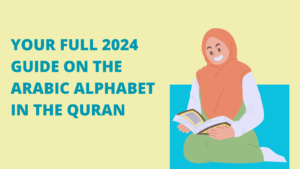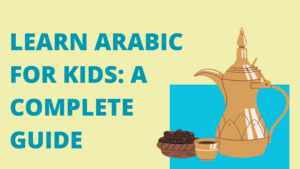Idghaam is an important concept in Tajweed, which refers to the merging or blending of two letters when pronounced together. Different types of Idghaam occur in the recitation of the Quran.
Idgham in Tajweed refers to the merging or absorption of the sound of ن (noon) with Sukoon or Tanween into the following letter, according to specific conditions. This rule helps maintain a smooth flow and correct pronunciation of words during recitation.
Let’s explore these types in more detail:
Table of Contents
Types of Idgham in Tajweed
Idgham is an essential rule in Tajweed that involves merging two letters when they appear consecutively in a word. There are different types of Idgham, each with its own rules and characteristics. Let’s explore them below:
1. Idgham With Ghunnah:
Idgham With Ghunnah occurs when a consonant letter (waw, yaa, noun, meem) comes after the Noon Sakinah or Tanween. The two letters merge into one stressed letter of the second gender, accompanied by the ghunnah.
In other words, Idgham With Ghunnah occurs when a Tanween or Noon Saakinah is followed by any of the letters waaw (و), meem (م), noon (ن), or yaa (ي).
The nasal sound, known as Ghunnah, is assimilated into a non-nasal sound and is prolonged for one vowel count. This results in a slight nasalization of the sound.
To indicate Idgham with Ghunnah, a small circle is placed above the non-nasal letter. The duration of the Ghunnah is approximately two seconds or two beats.
Example of Idgham with Ghunnah in the Quran
An example of Idgham with Ghunnah is found in the verse “وَجَعَلْنَا سِرَاجًا وَهَّاجًا” (Surah An-Naba:13).
In this example, the letter و (waw) in the word وَهَّاجًا comes after Tanween, and its sound hides the sound of the letter جً (jeem), which is joined with the letter و (waw).
The letter أ (alif) at the end of the word سِرَاجًا becomes unclear or merges with the previous letter due to Idgham with Ghunnah.
Another example, in the verse “وَمَن يَعْمَلْ” (wa man ya’mal), the Yaa after the Noon Sakinah is pronounced with the ghunnah.
2. Idgham Without Ghunnah:
Idgham Without Ghunnah occurs when the nasal sound is assimilated into a non-nasal sound without prolonging the nasal sound. It is marked with a small vertical line above the non-nasal letter.
In other terms, Idgham Without Ghunnah happens when a consonant letter (lam, ra) comes after the Noon Sakinah or Tanween. The two letters merge into one stressed letter of the second gender, without the accompanying ghunnah.
Two letters fall under Idgham without Ghunnah, which are Laam (ل) and Raa (ر). When either of these letters comes before a Noon Ssakinah, the Noon Ssakinah is concealed, and the letter after it is attached to either ل (Laam) or ر (Raa).
If the letter ل or ر comes after Tanween, the reader should articulate the sound (n) that arises because of At-tanween.
Example of Idgham without Ghunnah in the Quran
An example of Idgham without Ghunnah is found in the verse “فَإِنِ انْتَهَوْا فَإِنَّ اللَّـهَ غَفُورٌ رَحِيمٌ” (Surah Al-Baqarah, verse number 192).
In this example, since Tanween in the word غَفُورٌ is followed by the letter ر (raa) in رَحِيمٌ, Tanween should be concealed and read with the Arabic phonetic sign Dummah, merging it with the next letter.
So instead of pronouncing it as “Ghafoorun Raheem,” it should be pronounced without Ghunnah as “Ghafoor-ur-Raheem”.
3. Idghaam Taam (Kamil – complete):
Idghaam Taam occurs when the subjunctive letter with the same adjective is dropped, resulting in one fully stressed letter. It applies to the letters lam, ra, noon, and meem.
An example is the verse “مِّن لَّبَنٍ” (min labanin), where the lam and the noun merge into one stressed letter.
4. Idgham Naqis
Idgham Naqis is a term used to describe a short form of Idgham. To understand what Idgham Naqis means, we need to first know about Idgham Kamal (full).
Idgham Naqis involves inserting the first letter with the second letter, which is a substance and not an adjective.
In Idgham Kamal, the first letter is completely hidden, and only the second letter is pronounced, merging the two letters into one fully stressed letter.
Idgham Kamal applies to four letters: ن (noon), ل (lam), م (meem), and ر (ra). On the other hand, Idgham Naqis occurs when we insert the first letter into the second letter instead of dropping it.
Example of Idgham Naqis in the Quran
An example of Idgham Naqis is found in the verse “فَمَكَثَ غَيْرَ بَعِيدٍ فَقَالَ أَحَطْتُ بِمَا لَمْ تُحِطْ بِهِ وَجِئْتُكَ مِنْ سَبَإٍ بِنَبَإٍ يَقِين” (Famakatha ghayra ba’eedin faqala ahathtu bima lam tuhit bihi waji’tuka min Saba’in binabi’in yaqeen).
In this verse, the word “أَحَطْتُ” (ahathtu) experiences short Idgham between the letters ط (ta) and ت (ta), where the reciter slightly joins the two letters instead of completely dropping them.
5. Idghaam Shafawi (Idghaam Meem Saakin):
The term “Idgham Shafawi” refers to the same thing as “Idghaam Meem Saakin”. Idghaam Shafawi is defined linguistically and technically as the merging of similar letters. In this case, it specifically refers to the merging of the silent letter “Meem” (م) with its kind, occurring only in the letter “Meem” itself.
Idghaam Shafawi results in a strengthened, single Meem sound, and it is called “Idgham Al-Mutamaathilayn” (Merging of the Similar). This type of Idgham is incomplete, as the nasal sound remains a characteristic of the merged letter.
Idghaam Shafawi Examples
Examples of Idgham Ash-Shafawi – Idgham Al-Mutamaathilayn:
“فهم مِّن مَّغْرَمٍ مُّثْقَلُونَ”
In this example, the Idgham of the silent Meem occurs only once in the phrase “fahum min.” As for the second strengthened Meem (in “min maghramin”), it falls under the rule of Idgham of the Tanween into the Meem. The third strengthened Meem (in “maghramin muthqaloon”) results from the Idgham of Tanween into the Meem.
6. Idghaam Mutamatsilain Sagheer:
This occurs when two consecutive letters are united in both the way out of the mouth and the adjective. Different rules are depending on the letters involved.
For example, in the verse “مِن نُّطْفَةٍ” (min nutfatin), the meem and the noun merge without ghunnah. In other cases, such as “فَلا يُسرِف فِي القَتلِ” (fala yusrifu fil qatli), there is no ghunnah except for meem and noon.
7. Idghaam Mutamatsilain Kabir:
Idghaam Mutamatsilain Kabir refers to two similar vowels merging into one. However, there are exceptions in Hafs bin Assem’s recitation.
Examples include “تَأمَنّا” (ta’amanna), where the two alefs merge into one noun, and “مَكَّنّي” (makkanani), where the two kasras merge into one.
8. Idghaam Mutamatsilain Mutlak:
Idghaam Mutamatsilain Mutlak involves two similar letters, with the first being a vowel and the second being static. It follows the rule of Izhar, where the letters are pronounced distinctly. An example is the word “نَنْسَخْ” (nansakh).
9. Idghaam Mutganis:
Idghaam Mutganis refers to the assimilation of two letters that unite as a way out but differ in an adjective. For example, in the phrase “أَحَطتُ” (ahtatu), the taa’ and the ta’ merge, while the adjective of the letter ta’ remains.
10. Idgham Mutaqaribain:
Idgham Mutaqaribain occurs when two consecutive letters are close in terms of their exit from the mouth and their adjective. It is limited to the letters lam and ra, such as in the verse “قُلْ رَبِّ” and the letters Qaf and Kaf, as seen in “نَخْلُقْكُمْ”.
Understanding the Tajweed Rules for Heavy and Light Letters helps us ensure correct pronunciation while reciting the Quran according to Tajweed rules. It enables us to maintain clarity and beauty in our recitation.
11. Idgham Mutaqaraibain
Idgham Mutaqaraibain is the rule that applies when two similar letters are consecutive. The reason for its name, Mutaqaraibain, is that the place of articulation (Makhraj) of these two letters is close to each other in the mouth.
In this case, the first letter is with Sukoon (a phonetic sign indicating the absence of a vowel), while the second letter has the phonetic sign Shaddah. When the second letter has Shaddah, the first letter should merge into it, creating a new sound.
Example of Idgham Mutaqaraibain in the Quran
An example of Idgham Mutaqaraibain is found in the verse “إِنَّ اللَّهَ سَمِيعٌ بَصِيرٌ” (Inna Allaha Sami’un Basirun). Here, the Tanween on the letter Ayn merges with the following letter Baa.
Immerse Your Child in the Wonders of Arabic: Online Learning with Expert Egyptian Tutors at Bayan Al-Quran
At Bayan Al-Quran, we offer online Arabic learning course for kids specifically designed for children. Our experienced tutors from Egypt have a strong understanding of Tajweed and can easily guide your child through the complexities of the Arabic language.
By enrolling your child in our program, you are allowing them to fully immerse themselves in the beauty of Arabic and cultivate a lifelong passion for it. Whether their goal is to become a Hafiz or simply strengthen their connection with Allah’s words, our courses provide a solid foundation for growth.
Join us at Bayan Al-Quran today and let our expert tutors help unlock your child’s potential in Arabic language skills and Quranic recitation!
Conclusion
Understanding and implementing the rules of Idgham in Tajweed is crucial for reciting the Quran correctly. By mastering this aspect of Tajweed, you can ensure that your pronunciation is accurate and that you are conveying the intended meaning of the sacred text.
Whether it’s Idgham with or without Ghunnah, Idgham Mutaqaribain, or any other type of Idgham, each variation has its own set of rules to follow.
If you’re interested in learning more about Tajweed and refining your recitation technique, consider joining our Quran with Tajweed online course for kids at Bayan Al-Quran Academy.





















